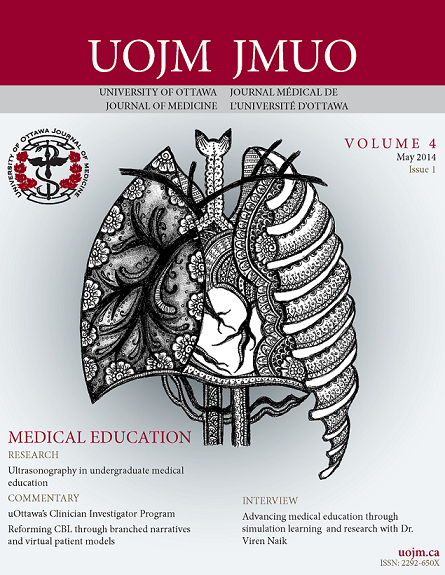Are Branched Narratives and Virtual Patient Models Acceptable Means of Reforming Case-based Learning?
DOI:
https://doi.org/10.18192/uojm.v4i1.1034Keywords:
case-based learning, CBL, branched narrative, virtual patient, VP, non-linear gameplay, branched story telling, non-lin¬ear CBL, interactive case, critical pathway, linear narrativeAbstract
Case-Based Learning (CBL) has become a major component of medical curricula and is featured prominently at the University of Ottawa. In this article, CBL is defined as a pedagogical method that uses fictional cases to reinforce important clinical skills [1]. Cases are organized into written sections pertaining to the patient’s chief complaint, a history and physical examination, laboratory and diagnostic investigations, as well as management and follow-up plans [1]. These cases are delivered through selfdirected online teaching modules or through group-oriented discussions. With either method, learners are expected to identify salient points from a given section, in order to anticipate the next steps in the management plan [1]. For example, if the history section describes a patient suffering from epigastric pain, students are encouraged to identify potential pain sources and use this knowledge to recognize the components that should be included in their approach to the physical examination. The ability to synthesize information to direct decision-making is a necessary competency of medicine supported by CBL [1-2]...Downloads
Published
2014-05-15
Issue
Section
Commentary
License
- Authors publishing in the UOJM retain copyright of their articles, including all the drafts and the final published version in the journal.
- While UOJM does not retain any rights to the articles submitted, by agreeing to publish in UOJM, authors are granting the journal right of first publication and distribution rights of their articles.
- Authors are free to submit their works to other publications, including journals, institutional repositories or books, with an acknowledgment of its initial publication in UOJM.
- Copies of UOJM are distributed both in print and online, and all materials will be publicly available online. The journal holds no legal responsibility as to how these materials will be used by the public.
- Please ensure that all authors, co-authors and investigators have read and agree to these terms.
- Works are licensed under a Creative Commons Attribution-NonCommercial-NoDerivatives 4.0 International License.


